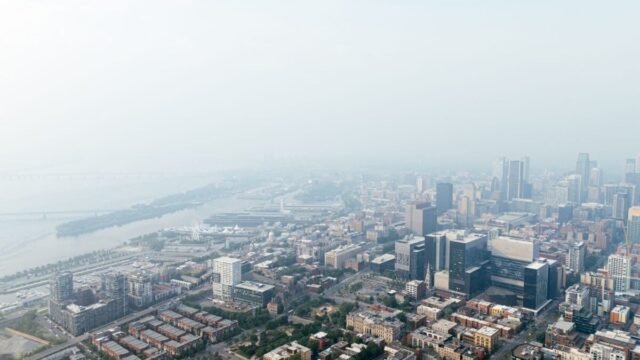Canada is battling more than 700 active fires across the country, about two-thirds of which have burned out of control, according to the Canadian Interstate Forest Fire Centre (CIFFC). Floods of smoke from the blazes have blanketed central Canada and the northern United States, prompting widespread air quality warnings.
Federal officials have issued air quality advisories for large swaths of Saskatchewan, Manitoba and western Ontario, where the majority of the wildfires are concentrated . Many cities across the region are experiencing “high risk” or “very high risk” air quality conditions that could persist through the end of the week, according to Environment Canada . The National Weather Service (NWS) in the United States has issued air quality advisories across the Midwest and Northeast. Several advisories cover entire states, including New York, Michigan, Wisconsin, Vermont and New Hampshire.
Swiss-based air quality monitoring database IQAir—which provides real-time air quality data—reported Minneapolis, Minnesota, had some of the worst air pollution in the world over the weekend, the Associated Press reported . “We’ve kind of been dealing with it, day in and day out, where you go outside and you can taste the smoke, you can smell it,” Joe Struss, a meteorologist with the Minneapolis-Saint Paul NWS office, told the AP.
Air quality advisories indicate that the air is unhealthy for vulnerable groups, including people with asthma, lung or heart disease, children and older adults. This means that wildfire smoke can affect the health of anyone, regardless of their age or pre-existing conditions. Even for healthy people, breathing in fine particles — the primary pollutant of concern in wildfire smoke — can temporarily reduce lung function, cause lung inflammation and trigger respiratory symptoms such as coughing and wheezing. The Environmental Protection Agency, NWS, and others in the area are advising those under the advisory to reduce their exposure to smoke by limiting their time outdoors.
This public health threat doesn’t appear to be going away anytime soon. Canada is currently experiencing one of its worst wildfire seasons, second only to 2023, when more than 6,000 fires have burned an estimated 37 million hectares (15 million acres) of land, according to Natural Resources Canada . So far this year, more than 4,000 fires have burned more than 16.5 million acres (6.7 million hectares), CIFFC reports .
In an update released Monday, Aug. 4, the agency said lightning strikes in Ontario and Alberta are igniting or threatening to ignite new fires. Eight more have been reported as of Tuesday, Aug. 5, according to the CIFFC. As Canada struggles to contain hundreds of out-of-control wildfires, the emergence of new blazes is a near-constant burden on Canadian firefighting forces nationwide.
This situation is “not unlike what we’ve seen in the last few years,” Monica Vaswani, a warning preparedness meteorologist at Environment Canada, told The Guardian. “Unfortunately, it’s kind of becoming a little bit more of the norm,” she said.
The reason for this is rising global temperatures. “Climate change is significantly increasing the flammability of the fuel available for fires because trees, fallen trees and undergrowth are so dry,” Yan Boulanger, a forest ecologist at Natural Resources Canada, said in 2024. “This means that a single spark, regardless of its source, can quickly turn into a blazing inferno.”
Experts have warned that Canada’s 2025 season is already on track to rival 2023. A warming planet will continue to shatter records, not just in Canada but around the world, as fire seasons intensify. The only way to truly extinguish this ongoing crisis is to address the fuel: greenhouse gas emissions.














